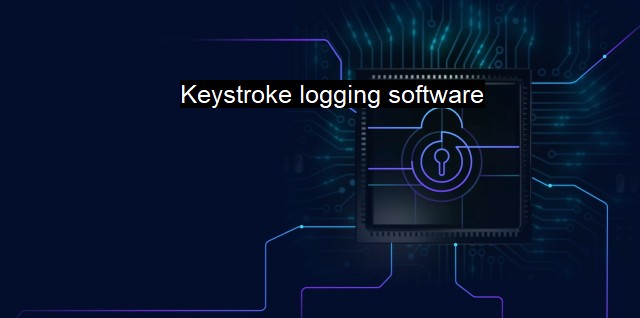What is Keystroke logging software?
The Risks and Benefits of Keystroke Logging Software: Protecting Your Data Beyond Cybercrime
Keystroke logging software, often referred to as a keylogger, is a type of surveillance technology used to record and track each keystroke made on a computer keyboard. This software is capable of capturing every word, number, and password that you input into your devices, giving external entities complete access to your sensitive data, and therefore, can compromise your cybersecurity.The way this software works is both simple and insidious. When you strike a key on your computer keyboard, the action triggers an interrupt signal to the processor. The keylogger effectively intercepts this signal, records the keystroke, and then passes the signal on to its destination as if nothing happened. Consequently, the user remains oblivious while their keyboard activity is covertly monitored and logged.
There are two types of keyloggers: hardware and software-based systems. The former pertains to physical devices that connect to the keyboard. These can be quickly detected and removed. The latter is more menacing and covert. It comes in the form of malware that infiltrates the computer system, stealthily recording keystrokes without the user's knowledge. This type is the most prevalent keylogging method used for cybercriminal activity.
Keyloggers have both legitimate and malicious uses. They were originally designed for legitimate needs - parents monitoring their children's internet use, employers observing their employees' productivity, or investigative agencies using them for tracking suspicious activity. But, they have also been utilized for cybercrimes like identity theft, phishing, corporate espionage, and fraud.
Keyloggers present a profound threat. The anonymous and everyday nature of digital communication creates a haven for cyber criminals who exploit keystroke logging software to gain unpermitted access to sensitive and private information.
The use of antivirus software plays a critical role in combatting this risk, working to detect and remove keystroke logging software. Good antivirus tools will scan the computer before it boots up, identifying any keylogging software before it activates. They also continually monitor your system for signs of cyber threats and are updated regularly to respond to the latest threats.
Antivirus software is not infallible because of two main reasons: firstly, they may fail to detect a threat if keylogging software has been altered to avoid signature-based identification by antivirus solutions. Secondly, zero-day attacks, which exploit software vulnerabilities before they are identified and fixed might also slip through.
Therefore, considering the adaptive, hidden nature of keylogging software, certain precautions must be adopted. Strengthening passcodes, securely maintaining backups, making use of encrypted communication platforms, updating software regularly, and maintaining an understanding of cybersecurity basics can enhance the security framework. It's also crucial to avoid suspicious links and to secure networks with VPNs.
Use of firewalls combined with network monitoring tools can add another layer of protection. Control over privileged access, regular audits, making essential security investments, and developing an emergency incident response strategy can further fortify network security.
Keystroke logging software, an unassuming yet remarkably dangerous type of surveillance technology, has enormous potential for misuse within the cyber realm. Through basic precautions, strategic cybersecurity enhancements, and a vigilant antivirus response, computers can be shielded better from this intrusive software, serving to protect personal and organizational integrity and privacy in the digital era.

Keystroke logging software FAQs
What is keystroke logging software?
Keystroke logging software (also known as keyloggers) is a type of software that covertly records every keystroke typed on a keyboard. This includes passwords, credit card numbers, and other sensitive information, which can then be accessed by the person who installed the keylogger.Why is keystroke logging software considered a security threat?
Keystroke logging software is considered a security threat as it can be used by cybercriminals to steal sensitive information such as usernames, passwords, and credit card details. This information can then be used for identity theft or fraud. Additionally, some keyloggers have the ability to capture screenshots, log internet activity, and record microphone and webcam activity, making them a powerful tool for cyber espionage.What are some common uses of keystroke logging software?
Keystroke logging software can be used for a variety of purposes, both legitimate and illegitimate. Some legitimate uses include monitoring employee productivity, detecting unauthorized access to a computer, and recovering lost data. However, keyloggers are also commonly used for malicious purposes, such as stealing credit card information, monitoring a spouse's activity, or spying on political dissidents.How can I protect myself from keystroke logging software?
To protect yourself from keystroke logging software, it is important to keep your antivirus software and operating system up to date. Avoid downloading software or attachments from unknown sources, and be cautious of suspicious emails or links. Consider using a virtual keyboard or password manager to enter sensitive information, as keyloggers usually cannot record mouse clicks or touchscreen taps. Finally, if you suspect that your computer has been compromised, run a full scan with your antivirus software and consider hiring a professional to remove any keyloggers or other malware.| | A | | | B | | | C | | | D | | | E | | | F | | | G | | | H | | | I | | | J | | | K | | | L | | | M | |
| | N | | | O | | | P | | | Q | | | R | | | S | | | T | | | U | | | V | | | W | | | X | | | Y | | | Z | |
| | 1 | | | 2 | | | 3 | | | 4 | | | 7 | | | 8 | | |||||||